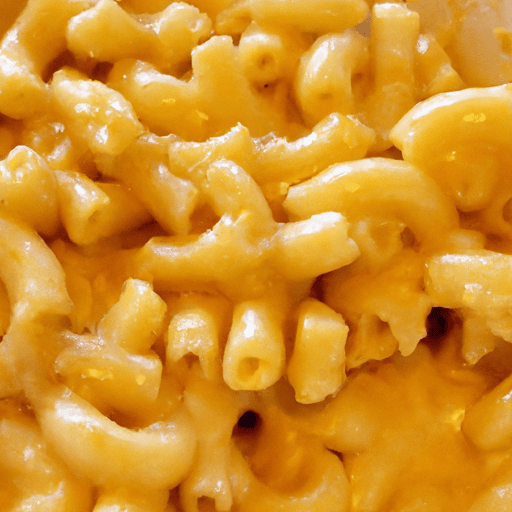Comfort Food Delight: Macaroni and Cheese
Macaroni and cheese—a classic combination that instantly brings a smile to your face. Its creamy, cheesy goodness never fails to provide the ultimate comfort food experience. Whether you’re a fan of the traditional stovetop version or the baked casserole style, macaroni and cheese is a dish that has stood the test of time and continues to be a beloved favorite for all ages.
The Taste Sensation
Macaroni and cheese is a marriage of two simple ingredients that creates a harmonious explosion of flavor. The pasta, most commonly elbow macaroni, is cooked to perfection—tender yet slightly firm—and then smothered in a rich, velvety cheese sauce. The cheese imparts a tangy and salty undertone, perfectly balanced by the smoothness of the sauce. Every bite is a heavenly blend of textures and tastes that dance on your palate, leaving you craving more.
Versatile in the Kitchen
The versatility of macaroni and cheese is what makes it so appealing to home cooks and chefs alike. As a standalone dish, it can be a crowd-pleasing main course or a satisfying side dish. But it doesn’t stop there; macaroni and cheese can also be customized with an array of add-ins, allowing you to get creative in the kitchen. From crispy bacon and sautéed mushrooms to roasted vegetables and spicy jalapenos, the options are endless. This culinary freedom lets you cater to your own personal preferences and experiment with flavors that tantalize your taste buds.
Nutritional Value
While macaroni and cheese may fall into the indulgent comfort food category, it does offer some nutritional value. The pasta provides energy-boosting carbohydrates, and the cheese brings calcium, protein, and essential vitamins. However, it’s worth noting that moderation is key, as the dish is often high in calories, saturated fat, and sodium. Enjoying macaroni and cheese as an occasional treat as part of a balanced diet is the best way to savor its deliciousness while maintaining a healthy lifestyle.
A Glimpse into History
Macaroni and cheese may seem like a modern-day comfort food staple, but its roots go way back. Believe it or not, this dish has been enjoyed for centuries. Its origins can be traced back to Medieval Europe, where pasta and cheese were commonly combined. Thomas Jefferson, America’s third president, is even credited with popularizing macaroni and cheese in the United States after encountering it during his travels in Europe. It has since become an integral part of American cuisine and is adored by people worldwide.
Fun Facts
- Kraft Macaroni & Cheese, the iconic blue box product, was first introduced in 1937, making it a household name for generations.
- There are numerous variations of macaroni and cheese, including the popular Southern-style mac and cheese with a breadcrumb topping, and the gourmet versions boasting a variety of artisanal cheeses.
- In 2015, a macaroni and cheese recipe from the 18th century was discovered in the archives of the New York Public Library. It included ingredients such as Parmesan cheese, butter, and nutmeg—proof that this comfort food has been enjoyed for centuries.
So, whether you enjoy a simple stovetop macaroni and cheese or prefer to get adventurous with your add-ins, this timeless dish remains a go-to comfort food that brings joy to countless plates around the world. Indulge in its unforgettable taste, learn from its fascinating history, and savor every delicious bite.
Macaroni and Cheese
Origin: Macaroni and cheese, also known as mac and cheese, originated in Italy, with a dish called “maccheroni al formaggio” dating back to the 13th century. The earliest known recipe for macaroni and cheese in English was published in 1769 by Elizabeth Raffald in her book “The Experienced English Housekeeper.”
Common Uses: Macaroni and cheese is a popular American comfort food dish made with cooked macaroni pasta and a cheese sauce. It is commonly served as a main course but can also be served as a side dish or as a component in other recipes. It is often baked with a breadcrumb topping.
Nutritional Benefits: Macaroni and cheese is a good source of protein, calcium, and phosphorus due to the cheese. The pasta provides carbohydrates for energy, and the cheese can also contribute to the intake of vitamins A and B12. However, it is important to keep in mind that macaroni and cheese can be high in saturated fat and calories, depending on the type of cheese used and the recipe.
Unique Properties and Historical Significance: Macaroni and cheese has a distinct creamy texture and a rich, cheesy flavor. It became particularly popular in the United States during the Great Depression when it was considered an affordable and filling meal. Macaroni and cheese also has cultural significance, being a staple dish at holiday gatherings and potluck dinners.
In 1937, Kraft Foods introduced the packaged “Kraft Dinner” (known as Kraft Macaroni & Cheese in the United States), which consisted of dried macaroni and a powdered cheese sauce mix. This innovative product contributed to the widespread popularity and accessibility of macaroni and cheese across the globe.
Macaroni and cheese has had various adaptations and variations throughout history, with different cheeses, herbs, and spices being added to create distinctive flavors.




Use the share button below if you liked it.
It makes me smile, when I see it.